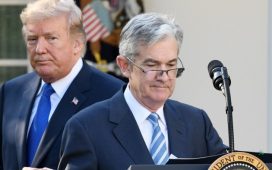Unlock the Editor’s Digest for free
Roula Khalaf, Editor of the FT, selects her favourite stories in this weekly newsletter.
Good morning. China’s stock rally has cooled. As we suspected it would, the Chinese government’s near silence about its fiscal stimulus plans has sapped investor enthusiasm. If Beijing does start cutting checks for infrastructure and consumption supports, will the market jump again? Email us: robert.armstrong@ft.com and aiden.reiter@ft.com.
Does inflation explain poor consumer sentiment?
Consumer sentiment is better now than it was in the dark days of 2022, but it has been weakening since this spring, and is still at the levels of the great financial crisis. There is a reasonably good explanation for this: consumers are still reeling from inflation. If you plot the University of Michigan consumer sentiment index against CPI inflation, you see a fairly reliable inverse correlation that goes back 70 years. Here I have inverted the scale for CPI to make the relationship easier to see:
Historical low points in consumer sentiment have also lined up with recessions. Inflation, that is to say, has tended to be stagflation. We can see this by comparing consumer sentiment and the unemployment rate (again, I’ve inverted unemployment here; the midpoints of official recessions are marked by dotted lines):
There is a curious thing, though. This time around, except for a very brief, very violent recession in spring 2020, the link between sentiment and unemployment has been broken. Unemployment is very low, and sentiment is lousy anyway.
What to make of this? One might argue that as inflation moves into the background, sentiment is set to rise further, so long as unemployment stays low. That would bode well for the economy and for markets. But I wonder if, during the pandemic years, something changed regarding how people think and feel about the economy.
The packaged food earnings recession
Late last year Unhedged wrote several pieces about how packaged foods stocks had been doing remarkably badly. We struggled to understand what was going wrong:
Part of it can be explained idiosyncratically. Several of the S&P food stocks are simply performing badly. Many companies in the group are only generating revenue growth because of price increases; volumes are flattish. But ConAgra, Hormel and Tyson aren’t even managing price increases. Kraft Heinz is getting price, but only at the cost of falling volumes. Both Campbell’s and Smucker’s have made big acquisitions (Rao’s pasta sauce and Hostess snacks, respectively) that investors didn’t seem to like. But these individual failures, it seems to me, don’t quite account for the stomach-churning performance of the group . . . It can’t all be down to the GLP-1 diet drugs.
I knew that the food companies had continued to disappoint, but I wasn’t aware of how pervasive the malaise had become until I read several interesting posts on Adam Josephson’s Substack, As the Consumer Turns. Josephson provides this striking list of consumer companies that have cut their sales or earnings targets in the past four month or so:

The numerous disappointments are visible in the performance of the S&P 500 Food Products sector, which had managed to keep up with the index in 2022, when defensives stocks were in demand:

As Josephson points out, this is out of step with what otherwise looks like a strong economy driven by strong consumer spending.
Part of the problem is visible in the macroeconomic data. Here is growth in several categories of real consumer expenditure since the start of the pandemic:

Goods consumption growth has trailed services, and was negative for much of 2022. Food and drinks has trailed goods, and has only just returned to positive territory.
Why? For goods generally, the problem could be a long echo of the pandemic lockdowns, when we all stayed at home ordering Peletons and air fryers. That was all demand pulled forward from the future, resulting in a slump that is only ending now. But it’s hard to pull forward much demand for food, unless it’s in cans.
One possibility is that branded food companies have conceded market power to the big retailers and their house brands. Packaged food companies have less pricing power than they once did, and have had to concede more margin to retailers to move their products. Warren Buffett attributes the weak performance of his investment in Kraft to this phenomenon.
The bad performance of food companies has not made their stocks cheap, at least not collectively. The forward price/earnings ratio of the sector, at 16, is historically normal. The bad performance of the stocks is all down to poor earnings growth. Until that changes, there seems little reason to bet on the sector.
Was the strong US jobs report anomalous?
On Monday, we threw some doubt on September’s job numbers, pointing out that 1) it is likely to be revised down given recent issues with the birth-death model, and 2) 254,000 is not terrific given the increasing size of the labour force. Others have echoed our scepticism. Here are some of their points:
-
Hiring and quits: Claudia Sahm points out that August’s Jolts report showed that the hiring rate fell, reaching a level historically in line with much higher unemployment. Peter Coy adds that quitting rates are also down, at a post-pandemic low. A labour market where employees do not feel comfortable quitting their jobs, either because they fear a downturn or because other companies are not hiring, suggests some underlying weakness, despite banner jobs creation.
-
Temporary workers and hours worked: Paul Ashworth at Capital Economics points out that the steady decline in temporary employment and hours worked is also in line with weaker payroll growth. This is good news on the inflation front, as the economy has plenty of people ready to work more if things start heating up. Average hours worked and the number of temporary employees look like they are coming back in line with their pre-pandemic trends rather than falling below it. Still, as Ashworth says, the rate of change is consistent with a weakening labour market.
We are highlighting these arguments not necessarily because we are convinced by them, or because we think the jobs report was terrible. But we do think it is possible that September could have been an anomaly (even as we hope that it wasn’t).
(Reiter and Armstrong)
One good read
FT Unhedged podcast

Can’t get enough of Unhedged? Listen to our new podcast, for a 15-minute dive into the latest markets news and financial headlines, twice a week. Catch up on past editions of the newsletter here.











